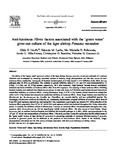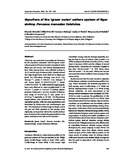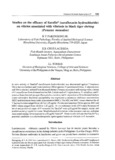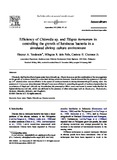Anti-luminous Vibrio factors associated with the ‘green water’ grow-out culture of the tiger shrimp Penaeus monodon
Share
Abstract
The ability of the “green water” grow-out culture of the tiger shrimp Penaeus monodon to prevent outbreaks of Luminous Vibriosis was investigated by screening associated isolates of bacteria, fungi, phytoplankton and fish skin mucus for anti-luminous Vibrio metabolites. Among the 85 bacterial isolates tested, 63 (74%) caused +∼+++ inhibition of the Vibrio harveyi pathogen after 24–48 h co-cultivation. The variation in growth inhibition rates of +, ++, and +++ were demonstrated by 15 (18%), 13 (15%), and 28 (33%) isolates, respectively, 24 h after treatment. Eight bacterial isolates showed consistently sustained maximum inhibition of luminous Vibrio after 24 to 48 h exposure. The majority of these luminous Vibrio inhibiting bacterial isolates were obtained from tilapia mucus and gut. In tests with fungi, 4 of 20 (20%) yeast isolates showed intracellular metabolites inhibitory to luminous Vibrio. Among filamentous fungi, 5 of 45 (11%) isolates yielded intracellular metabolites while 3 of 41 (7%) isolates had extracellular metabolites inhibitory to luminous Vibrio. These fungal isolates were identified as Rhodotorula sp., Saccharomyces sp., Candida sp., Penicillium sp., mycelia sterilia, and two unidentified species. The microalgae, Chaetoceros calcitrans and Nitzchia sp., consistently demonstrated complete inhibition of luminous Vibrio from 24 h and 48 h post exposure, respectively, and during the 7-day experiment. Leptolyngbia sp. caused a 94–100% reduction of the luminous Vibrio population from 104 to 101 cfu/ml 24 h post exposure which was sustained throughout the 10-day observation period. In contrast, the inhibitory effects of Skeletonema costatum on luminous Vibrio was bacteriostatic throughout the 7-day exposure while Nannochlorum sp. did not significantly inhibit luminous Vibrio. The skin mucus of jewel tilapia, Tilapia hornorum, had no resident luminous bacteria and inhibited this bacterial pathogen in 6–48 h, which was proportionate to the 103 and 105 cfu/ml test concentrations of luminous Vibrio. This study provides a scientific explanation that the effectiveness of the “green water” culture of tiger shrimp (P. monodon) in preventing outbreaks of luminous Vibriosis among P. monodon juveniles in grow-out ponds can be attributed to the presence of anti-luminous Vibrio factors in the bacterial, fungal, phytoplankton microbiota and the skin mucus of tilapia associated with this novel technique of shrimp culture.
Keywords
Green water culture Tiger shrimp Anti-luminous Vibrio Bacteria Fungi Phytoplankton MetabolitesSuggested Citation
Lio-Po, G. D., Leaño, E. M., Peñaranda, M. M. D., Villa-Franco, A. U., Sombito, C. D., & Guanzon, N. G., Jr. (2005). Anti-luminous Vibrio factors associated with the ‘green water’ grow-out culture of the tiger shrimp Penaeus monodon. Aquaculture , 250(1-2), 1-7. https://doi.org/10.1016/j.aquaculture.2005.01.029
Subject
aquaculture techniques; bactericides; bioactive compounds; disease control; Fungi; inhibitors; metabolites; mucus; pathogenic bacteria; phytoplankton; pond culture; screening; shrimp culture; vibriosis; yeasts; Bacteria; Candida; Mycelia sterilia; Nannochlorum; Penaeus monodon; Penicillium; Rhodotorula; Saccharomyces; Skeletonema costatum; “Green water” culture; Vibrio; Tiger shrimp
Taxonomic term
Collections
- AQD Journal Articles [1249]
Related items
Showing items related by title, author, creator and subject.
-
Mycoflora of the 'green water' culture system of tiger shrimp Penaeus monodon Fabricius
Leaño, Eduardo M.; Lio-Po, Gilda D.; Nadong, Lorena A.; Tirado, Analyn C.; Sadaba, Resurreccion B.; Guanzon, Nicolas G. (Blackwell Publishing Ltd, 2005)This study was conducted to quantify and characterize the mycoflora associated with the ‘green water’ culture system of Penaeus monodon. Samples of water, tilapia gut and mucus, and shrimp hepatopancreas from three shrimp ... -
Studies on the efficacy of Sarafin® (sarafloxacin hydrochloride) on vibrios associated with vibriosis in black tiger shrimp (Penaeus monodon)
Pakingking, Rolando V., Jr.; Lacierda, Erlinda; Torres, James L. (Fish Health Section, Asian Fisheries Society, 2002)In vitro activity of Sarafin® (sarafloxacin hydrochloride) was determined against 7 luminous Vibrio harveyi isolates and 3 non-luminous Vibrio species (V. parahaemolyticus, V. alginolyticus and Vibrio species) isolated ... -
Efficiency of Chlorella sp. and Tilapia hornorum in controlling the growth of luminous bacteria in a simulated shrimp culture environment
Tendencia, Eleonor; dela Peña, Milagros R.; Choresca, Casiano H., Jr. (Elsevier, 2005)This study clarifies the effect of green water from Chlorella sp., Tilapia hornorum and the combination of the two organisms on the growth of luminous bacteria in a simulated shrimp culture environment. Results showed that ...




